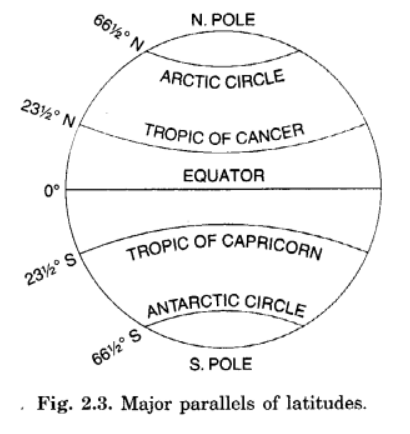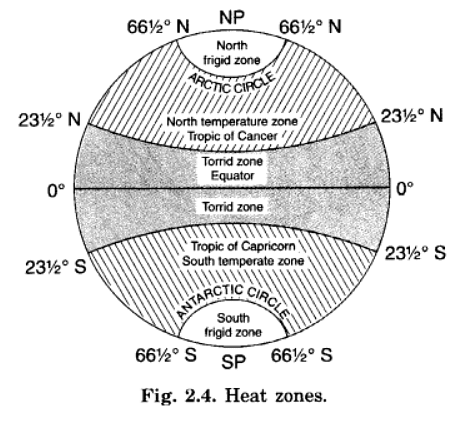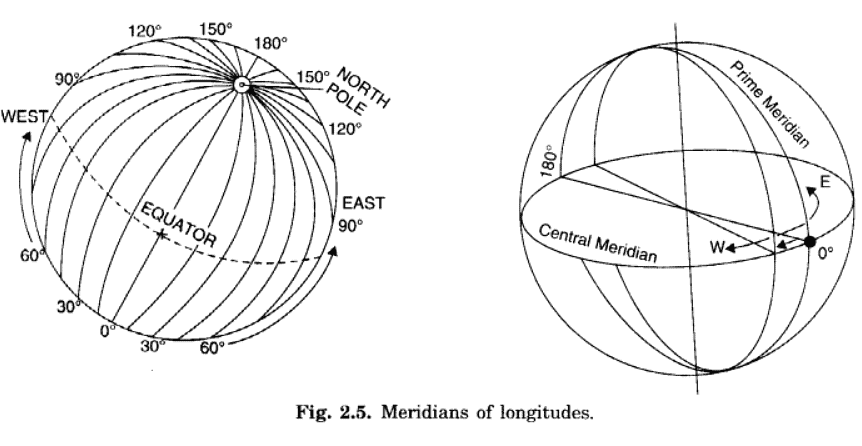Long Questions: Globe: Latitudes and Longitudes | NCERT Summary: UPSC PDF Download
Q1: Why do we have Standard Time?
Ans:
- Places located on a meridian of longitude have the same time. It is called local time.
- Time at a meridian of longitude differs from the time of another meridian of longitude by 4 minutes (either less by 4 minutes or more by 4 minutes).
- The local time of Dwarka (Gujarat) lags behind by 1 hour 45 minutes from that of Dibrugarh (Assam).
- A person going from west to east will have to advance his/her watch by 4 minutes after crossing a meridian. On the other hand, a person going from east to west will have his/her watch moved backwards by 4 minute at each meridian. This creates problem for him.
- To remove this problem the local time of a central meridian of the country is assumed standard for the whole country. It is called Standard Time.
- All the watches indicate the same time in all parts of the country.
- People do not have to move their watches advanced or backed.
- All the work is done according to this time.
- In India the local time of 82°30′ E is taken as standard for the whole country. It is called Indian Standard Time (IST).
Q2: What is the Meridian that is taken as the standard time of India?
Ans: In India, 82° 30' E is regarded as a standard meridian because the time difference between 1° longitude and 82° 30' E is 4 minutes.
The whole longitudinal space of India is 30 degrees (97°E - 67°E = 30°E). As a result of the total time difference of 30 X 4 = 120 minutes or 2 hours, the time difference between Gujarat and Arunachal Pradesh is 2 hours.
We chose a standard meridian to avoid such confusion and to ensure that everyone in the country is on the same time.
Q3: Why is having a standard time is necessary? Define IST.
Ans: Indian Standard Time is abbreviated as IST. Every country must have a standard time zone. The following things will help to understand it:-
- Time zones are important when creating a schedule for trains and aircraft. It's difficult to build a time table without a common time because different time zones have different times.
- Standard time also aids in maintaining time consistency across the country.
- The standard meridian is located at a longitude of 82°30'E and is known as IST (Indian Standard Time). This meridian is used to calculate India's standard time.
Q4: Kabeer lives in a small town near Bhopal. He tells his friend Alok that they will not be able to sleep tonight. A day and night cricket match between India and England had started, at 2 p.m. in London. This means that the match would finish well after 1 a.m. in the night. The match according to Indian Standard Time (1ST) has started at 7.30 p.m.
Do you know what is the time difference between India and England?
Ans:
- Vindhyachal (Mirzapur Distt., U.P.) -India is located east of Greenwich at 82°30′ E. Its time is 5 hours and 30 minutes ahead of Greenwich (London) (The GMT).
- So it will be 5.30 p.m. in India when it is 12.00 noon at London.
- When the cricket match starts at London at 2 p.m. The time of match-start in India is 7.30 p.m.
- Kabeer will not be able to sleep that night because the match will be seen in India during the night.
Q5: What are the meridians of longitude and parallels of latitude?
Ans: The imaginary line that separates the planet into the Northern and Southern Hemispheres is known as the Equator. By 0 degrees latitude, the equator is represented. The North Pole is located at 90° north latitude, whereas the South Pole is located at 90° south latitude. The world is divided into equal halves by this circular line. From the equator to the poles, there are parallel circles. The measurement units for latitudes are degrees.
Q6: Torrid zones receive maximum amount of heat, why?
Ans: The Torrid Zone is located between the Tropics of Cancer and Capricorn. On all of the latitudes included in this area, the midday sun is directly overhead once a year. This occurs as a result of the fact that this area receives the most heat. Because the sun's rays fall vertically on this region, the torrid zone receives the most heat throughout the year. It is between the Tropics of Cancer and Capricorn, between 23 1/2N and 23 1/2S.
Q7: How do longitudes help us in calculating time?
Ans: Longitude and Time:
- Longitudes help us to calculate time.
- Time is measured by the movement of the Earth.
- The Earth moves on its axis from West to East. It is called rotation.
It takes 24 hours for the earth to complete one rotation:
- This means in 24 hours the Earth completes 360°.
- Hence, it takes about 4 minutes for crossing one degree of longitude (or it takes one hour in crossing 15 degrees of longitude)
- Accordingly, the Earth has been divided into 24 time zones of one hour each.
- This means each place has different time of Sunrise and Sunset.
- Places east of the Greenwich Meridian experience day or sunrise earlier than the places lying west of this Meridian. In other words time is ahead in the east than that in the west, at the rate of 4 minutes per degree of longitude.
Q8: What is Standard Time?
Ans: Standard Time:
- Local time of a place is based on the longitude of that place. It means places situated on different meridians will have different local tidies.
- It creates much confusion and problem for people to function.
- To solve these problems every country fixes its central meridian, which is considered the standard meridian of that country.
- The local time of this meridian is considered standard for the whole country. It is called standard time.
- In India the longitude of 821/2°E (82° 30° E) is treated as the standard meridian.
- The local time of this meridian is followed all over the country.
- This is known as Indian Standard Time (IST).
- Through an international agreement, the local time of all places is linked to the Greenwich Mean Time (GMT). Different places have different times.
Q9: Explain about the three heat zones of the earth.
Ans: The earth's three heat zones are:
- Torrid Zone: The Torrid Zone is the region between the Tropics of Cancer and Capricorn that receives the highest heat.
- Temperate Zone: This is the area in the northern hemisphere between the Tropic of Cancer and the Arctic Circle, and in the southern hemisphere between the Antarctic Circle and the Tropic of Capricorn. The temperature is moderate.
- Frigid Zone: This part of the world is quite chilly. In the northern hemisphere, this is the area between the Arctic Circle and the North Pole, while in the southern hemisphere, it is the area
between the Antarctic Circle and the South Pole.
Q10: Describe important parallels of latitudes.
Ans: Important Parallels.
Equator:
- Equator is the longest parallel running in the East-West direction.
- It is a great circle.
Tropic of Cancer:
- It is the parallel of 23 1/2° N in the Northern hemisphere.
Tropic of Capricorn:
- It is the parallel of 23 1/2° S in the Southern hemisphere.
Arctic Circle:
- It lies at 66 1/2° north of the equator.
Antarctic Circle:
- It lies at 66 1/2° south of the equator.
90° Parallel:
- It is shown by a point.
- Its length is zero.
North Pole:
- It is at 90° north of equator.
South Pole:
- It is at 90° south of equator.

Q11: Describe major heat zones of the Earth.
Ans: Heat Zones of the Earth.
1. Torrid Zone:
- Torrid means hot.
- This zone receives the maximum amount of heat throughout the year, because the rays of the Sun fall vertically on this zone.
- This zone is located between the Tropic of Cancer (23 1/2° N) and the Tropic of Capricorn (23 1/2° S).
2. Temperate Zone:
- The temperate zones lie in both the hemispheres.
- North temperate zone lies in northern hemisphere between Tropic of Cancer and Arctic Circle.
- South temperate zone lies in the southern hemisphere between the Tropic of Capricorn and Antarctic Circle.
- These zones are neither too hot nor too cold.
3. Frigid Zone:
- Frigid means cold.
- Beyond the Arctic Circle and Antarctic Circle temperatures are very low and the climate is very cold.
- This is due to the extreme slanting of the Sun’s rays.
- The North Frigid Zone lies between the Arctic Circle (66 1/2° N) and the North Pole in the Northern hemisphere.
- The South Frigid Zone lies between Antarctic Circle (66 1/2°S) and the South Pole in the Southern hemisphere.

Q12: Explain major features of meridians.
Ans: The following are the major features of meridians:
- Meridians are equal in length.
- The longitude running through the Greenwich pear London was first chosen as the Prime Meridian (Prime Meridian means chief or main meridian) having noon at the same time at all places on this line.
- It is the 0° longitude.
- It divides the earth into eastern and western hemispheres.

- They are semicircles.
- They are 360 in all -180 in the East and 180 in the West of Prime Meridian. 180°E and 180° W is one longitude.
|
666 docs
|




















